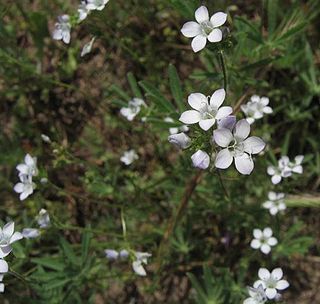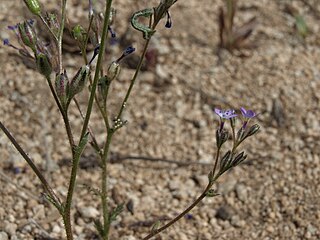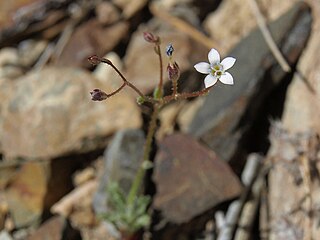
Gilia angelensis is a species of flowering plant in the phlox family known by the common name chaparral gilia. It is native to the coastal hills and mountains of California and Baja California, where it is a member of the chaparral ecosystem., especially in the Transverse Ranges.

Gilia brecciarum is an annual flowering plant in the phlox family (Polemoniaceae), known by the common name Nevada gilia or break gilia.

Gilia cana is a species of flowering plant in the phlox family known by the common name showy gilia. It is native to California and Nevada where it grows in open areas with gravelly and sandy soils, such as desert and rocky slopes. The Mojave Desert range of some subspecies may extend into Arizona.

Gilia capitata is a species of flowering plant in the phlox family known by the common names blue-thimble-flower, bluehead gilia, blue field gilia, and globe gilia.

Gilia clivorum is a species of flowering plant in the phlox family known by the common names purplespot gilia and many-stemmed gilia. It is native to California and Arizona.

Gilia malior is a species of flowering plant in the phlox family known by the common name scrub gilia. It is native to California and Nevada, where it grows in sandy and rocky soils in the lower and mountain habitats in the Mojave Desert.
Gilia minor is a species of flowering plant in the phlox family known by the common name little gilia. It is native to the Mojave Desert and it is also present in the coastal Santa Lucia Mountains of central-southern coastal California.
Gilia ophthalmoides is a species of flowering plant in the phlox family known by the common name eyed gilia. It is native to the Southwestern United States where it can be found in woodlands and high desert plateau.

Gilia scopulorum is a species of flowering plant in the phlox family known by the common names rock gilia and Rocky Mountain gilia. It is native to the Mojave and Sonoran Deserts.

Gilia aliquanta is a species of flowering plant in the phlox family known by the common name puffcalyx gilia. It is native to the Sierra Nevada mountains and deserts of southeastern California and southern Nevada.

Gilia clokeyi is a species of flowering plant in the phlox family known by the common name Clokey's gilia. It is native to the south-western United States from California to Colorado, where it grows in desert and other habitat.
Gilia diegensis is a species of flowering plant in the phlox family known by the common name coastal gilia.

Aliciella leptomeria is a species of flowering plant in the phlox family known by the common names sand gilia and Great Basin gilia. It is native to the Western United States, where it grows in many types of habitat, such as the sagebrush of the Great Basin and in the Mojave Desert.

Linanthus maculatus is a species of flowering plant in the phlox family known by the common names San Bernardino Mountain gilia and Little San Bernardino Mountains gilia. It is endemic to California, where it is known only from a few locales in the Little San Bernardino Mountains and the adjacent Palm Springs area in the northern end of the Coachella Valley. The largest populations, which may contain thousands of individuals, are located within the bounds of Joshua Tree National Park. This is a very small annual herb no more than three centimeters high. It has a taproot which may exceed 6 centimeters in length to collect moisture from the dry desert sand in its native habitat. The tiny, hairy stem branches to form small matted clusters on the sand surface. The hairy leaves are just a few millimeters long and unlobed. The inflorescence is a dense cluster of flowers each only 2 to 5 millimeters wide. The flower corolla has curled-back lobes which are white, sometimes with a spot of purple or pink. The protruding stamens are yellow. The main threat to this species is development in its range, and it is also vulnerable to off-road vehicle damage in the wide open sandy flats where it grows.
Gilia salticola is a species of flowering plant in the phlox family known by the common name salt gilia. It is native to the Sierra Nevada and Modoc Plateau of California and western Nevada, where it grows in volcanic and granitic soils.
Aliciella subacaulis is a species of flowering plant in the phlox family known by the common name pinyon gilia. It is native to the western United States from California to Wyoming, where it grows in several types of habitat, such as sagebrush and desert woodlands. This herb produces a glandular stem up to about 30 centimeters tall, surrounded at the base by an erect cluster of lobed leaves each up to 7 centimeters long. There are also smaller, unlobed leaves along the stem. The inflorescence is a loose cluster of purple-washed white flowers with yellow-spotted throats.
Gilia transmontana is a species of flowering plant in the phlox family known by the common name transmontane gilia. It is native to the western United States from California to Utah, where it grows in desert and plateau habitat.
Aliciella triodon is a species of flowering plant in the phlox family known by the common name coyote gilia. It is native to the American desert southwest from California to New Mexico, where it grows in desert habitat such as scrub and woodland. This small herb produces a thin, glandular stem not more than about 13 centimeters tall. The stem is surrounded by a basal rosette of fleshy, sharp-lobed leaves each up to 2 centimeters long. There are sometimes smaller, unlobed leaves on the stem itself. The inflorescence is a solitary flower or loose array of two or three flowers each about 5 to 7 millimeters wide. Each flower has a hair-thin tubular throat opening into a whitish corolla. The corolla lobes each have three distinct teeth.
Aliciella formosa is a species of flowering plant in the phlox family known by the common name Aztec gilia. It is endemic to New Mexico in the United States, where it is known only from San Juan County.

Saltugilia is a genus of flowering plants in the phlox family, Polemoniaceae. They are known commonly as woodland gilias. There are four species. Two are endemic to California in the United States, and the distributions of the other two extend into Baja California in Mexico.













